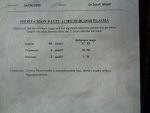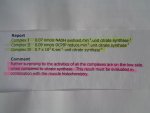Janet Dafoe
Board Member
- Messages
- 867
ME/CFS Working Group at Stanford Meeting September 8-10, 2021
Summary, by Ronald W. Davis, PhD, and Janet L Dafoe, PhD
This was a great meeting and showed a lot of activity and progress in ME/CFS in an ever-growing number of groups. Researchers presented unpublished and often preliminary results. This style of scientific meeting can greatly accelerate research because scientists learn new information much earlier. It can often take a year or more to get a research paper published. Because of the preliminary nature of the results, it is essential that they remain confidential and not made public. Therefore, this is a summary without too many details. The speakers are listed at the end.
There is continued search for a pathogen(s) that can sustain ME/CFS. Most studies look for DNA or RNA from a pathogen.In addition, EBV and HHV6 have gained renewed interest for researchers due to evidence of activation of these viruses in the absence of DNA replication and amplification.
There were a number of talks about the metabolomics of ME/CFS. This work is moving from finding lists of metabolites involved in the disease to investigating various metabolic pathways. A major focus is on the nitrogen and BH4 pathways. There is a new focus on pathways in the mitochondria. This is difficult to study because of the small amount of mitochondrial metabolites in blood samples. However, this focus may be at the heart of what’s wrong in ME/CFS.
There was new work presented regarding autoantibodies and immune dysregulation. It is believed this dysregulation is what is causing autoantibodies to be present. The next question is, “What is causing the immune dysregulation?” There was also new work on neuro-inflammation, which also might result from the immune dysregulation.
There was a preliminary report of the molecular changes occurring with PEM. This will be a major endeavor.
A major effort was reported of an extensive genetic analysis from published and unpublished DNA sequence data looking for single genes and combinations of genes and any correlations with phenotypes. This is the first attempt to put together these previously disparate groups of data, and it was exciting to see. Thus far, the results are preliminary, but this is a very important investigation.
We heard an update on red cell deformability. In previous work, some labs have found a difference in red cell deformability between patients and healthy controls, and one lab found no difference. However, it was recently discovered that oxygen levels in the blood have a major impact on deformability. New instruments are being developed to measure deformability under controlled oxygen levels. There is a clear difference in deformability between patients and healthy controls under low blood oxygen levels. Thus, this continues to provide promise for a fast and inexpensive biomarker and diagnostic test.
New results on metabolic traps were presented. It is possible that there are many different metabolic traps and that these traps may be the cause of a number of chronic diseases. The tryptophan to kynurenine trap has been the first to be explored as an underlying cause of ME/CFS. This trap was first demonstrated in a test tube using purified enzymes, but does it exist in vivo in isolated cells? Yes! It was demonstrated that yeast with the Human IDO1 gene inserted into it became trapped when tryptophan was increased in the medium. Work is now progressing to determine if Human cells can be trapped. Using the yeast system, screening is proceeding for an FDA approved drug that will reactivate the Human IDO1 enzyme and get the cell out of the trap. In addition, a new trap or energy bypass in mitochondria was presented that could explain the low energy in patients and PEM.
In between the presentations, there was a significant amount of time for questions, discussions, brainstorming and the forming of collaborations. It felt like the research on ME/CFS has reached a new level, and it engendered an ever growing spirit of hope for eventual treatments and a cure.
Particiipants:
Christopher Armstrong, Rahaf Assil, Lucinda Bateman, Jonas Bergquist, Joseph Breen, Lily Chu,Jane Collins, Laurel Crosby, Janet Dafoe, Mark Davis, Ron Davis, Kenny de Meirleir, Mary Dimmock, Donna Felsenstein, Jennifer Frankovich, Keith Geraghty, Arnaud Germain, Anna Gil, Ludovic Giloteaux, Eric Gordon, Michael Gresser, Andrew Crimson, Paul Guyre, Rebecca Hamlin, Maureen Hanson, Ashley Haugen, Craig Heller, Katrina Hong, Mady Hornig, Li-Yuan Hung, Fereshteh Jahaniani, Michael Jensen, Sharada Kalanidhi, David Kaufman, Betsy Keller, Ryan Kellog, Vinod Khosla, Seoyeon Kim, Nancy Klimas, Kevin Kramer, Crystal Lantz, Joshua Leisk, Susan Levine, Alan Light, Kathleen Light, Ami Mac, Jessica Maya, Roya Mazrouei, Neil McGregor, Alain Moreau, Karl Morten, Adam O’Neal, Anna Okumu, Robert Phair, Bhupesh Prusty, Anand Ramasubramanian, Amit Saha, Carmen Scheibenbogen, Liisa Selin, Jaime Seltzer, Amrit Shahzad, Peidong Shen, Richard Simpson, Michael Snyder, Rivka Solomon, Franziska Sotzny, Linda Tannenbaum, Ronald Tompkins, David Tuller, Marielle van Kooten, Vanessa Velasco, Jiandi Wan, John Whiting, Vicky Whittemore, Julie Whilhelmy, Wenzhong Xiao, Sitong Zhou
We are all extremely grateful to all the funders of this research, including, NIH, OMF, Vinod Khosla, international funders, and the awesome generosity of patients and their loved ones. As usual, the progress of this research is always slower than it potentially could be due to limited funds. Donations are so deeply appreciated!
Summary, by Ronald W. Davis, PhD, and Janet L Dafoe, PhD
This was a great meeting and showed a lot of activity and progress in ME/CFS in an ever-growing number of groups. Researchers presented unpublished and often preliminary results. This style of scientific meeting can greatly accelerate research because scientists learn new information much earlier. It can often take a year or more to get a research paper published. Because of the preliminary nature of the results, it is essential that they remain confidential and not made public. Therefore, this is a summary without too many details. The speakers are listed at the end.
There is continued search for a pathogen(s) that can sustain ME/CFS. Most studies look for DNA or RNA from a pathogen.In addition, EBV and HHV6 have gained renewed interest for researchers due to evidence of activation of these viruses in the absence of DNA replication and amplification.
There were a number of talks about the metabolomics of ME/CFS. This work is moving from finding lists of metabolites involved in the disease to investigating various metabolic pathways. A major focus is on the nitrogen and BH4 pathways. There is a new focus on pathways in the mitochondria. This is difficult to study because of the small amount of mitochondrial metabolites in blood samples. However, this focus may be at the heart of what’s wrong in ME/CFS.
There was new work presented regarding autoantibodies and immune dysregulation. It is believed this dysregulation is what is causing autoantibodies to be present. The next question is, “What is causing the immune dysregulation?” There was also new work on neuro-inflammation, which also might result from the immune dysregulation.
There was a preliminary report of the molecular changes occurring with PEM. This will be a major endeavor.
A major effort was reported of an extensive genetic analysis from published and unpublished DNA sequence data looking for single genes and combinations of genes and any correlations with phenotypes. This is the first attempt to put together these previously disparate groups of data, and it was exciting to see. Thus far, the results are preliminary, but this is a very important investigation.
We heard an update on red cell deformability. In previous work, some labs have found a difference in red cell deformability between patients and healthy controls, and one lab found no difference. However, it was recently discovered that oxygen levels in the blood have a major impact on deformability. New instruments are being developed to measure deformability under controlled oxygen levels. There is a clear difference in deformability between patients and healthy controls under low blood oxygen levels. Thus, this continues to provide promise for a fast and inexpensive biomarker and diagnostic test.
New results on metabolic traps were presented. It is possible that there are many different metabolic traps and that these traps may be the cause of a number of chronic diseases. The tryptophan to kynurenine trap has been the first to be explored as an underlying cause of ME/CFS. This trap was first demonstrated in a test tube using purified enzymes, but does it exist in vivo in isolated cells? Yes! It was demonstrated that yeast with the Human IDO1 gene inserted into it became trapped when tryptophan was increased in the medium. Work is now progressing to determine if Human cells can be trapped. Using the yeast system, screening is proceeding for an FDA approved drug that will reactivate the Human IDO1 enzyme and get the cell out of the trap. In addition, a new trap or energy bypass in mitochondria was presented that could explain the low energy in patients and PEM.
In between the presentations, there was a significant amount of time for questions, discussions, brainstorming and the forming of collaborations. It felt like the research on ME/CFS has reached a new level, and it engendered an ever growing spirit of hope for eventual treatments and a cure.
Particiipants:
Christopher Armstrong, Rahaf Assil, Lucinda Bateman, Jonas Bergquist, Joseph Breen, Lily Chu,Jane Collins, Laurel Crosby, Janet Dafoe, Mark Davis, Ron Davis, Kenny de Meirleir, Mary Dimmock, Donna Felsenstein, Jennifer Frankovich, Keith Geraghty, Arnaud Germain, Anna Gil, Ludovic Giloteaux, Eric Gordon, Michael Gresser, Andrew Crimson, Paul Guyre, Rebecca Hamlin, Maureen Hanson, Ashley Haugen, Craig Heller, Katrina Hong, Mady Hornig, Li-Yuan Hung, Fereshteh Jahaniani, Michael Jensen, Sharada Kalanidhi, David Kaufman, Betsy Keller, Ryan Kellog, Vinod Khosla, Seoyeon Kim, Nancy Klimas, Kevin Kramer, Crystal Lantz, Joshua Leisk, Susan Levine, Alan Light, Kathleen Light, Ami Mac, Jessica Maya, Roya Mazrouei, Neil McGregor, Alain Moreau, Karl Morten, Adam O’Neal, Anna Okumu, Robert Phair, Bhupesh Prusty, Anand Ramasubramanian, Amit Saha, Carmen Scheibenbogen, Liisa Selin, Jaime Seltzer, Amrit Shahzad, Peidong Shen, Richard Simpson, Michael Snyder, Rivka Solomon, Franziska Sotzny, Linda Tannenbaum, Ronald Tompkins, David Tuller, Marielle van Kooten, Vanessa Velasco, Jiandi Wan, John Whiting, Vicky Whittemore, Julie Whilhelmy, Wenzhong Xiao, Sitong Zhou
We are all extremely grateful to all the funders of this research, including, NIH, OMF, Vinod Khosla, international funders, and the awesome generosity of patients and their loved ones. As usual, the progress of this research is always slower than it potentially could be due to limited funds. Donations are so deeply appreciated!





